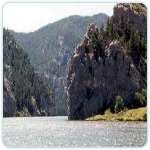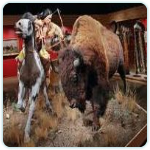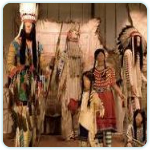Rocky Mountain Region: Montana: USA
Montana has many beautiful national parks. Its Glacier National Park is famous for its more than fifty glaciers, two hundred lakes, and many streams filled with rainbow trout. If you visit the National Bison Range you can watch bison’s, antelopes, bighorn sheep, deer, coyotes and grizzly bears roaming free.
Gates of the Mountains Mammoth limestone cliffs rise to 1,200 feet through the region named by Lewis and Clark. Here you can see ancient Native American pictographs and bighorn sheep, goats, and bald eagles. Some 300 million years in the making, Meriwether Canyon, through which the Missouri flows, is spectacular to see. Limestone cliffs, intricately folded and studded with fossil remains from the ancient Mississippian sea, rise sheer above the river to 1,200 feet. The “singular appearance” stunned Meriwether Lewis on the passage through here in 1805; it appeared the river had ended, until Lewis noted in his journal that the rocks opened up like “the Gateway to the Rocky Mountains.” The site can only be accessed by trail or boat. Cruises of the nearly six miles of gorge are available from Gates of the Mountains Landing. From the boat you can see ancient Native American pictographs and perhaps bighorn sheep, goats, and bald eagles. The boat stops at the Lewis and Clark campsite before its return run, where you can enjoy time off the boat swimming or bird-watching.
The People’s Center The three layers of stone that form the exterior of this museum—owned and operated by the now-confederated Salish, Kootenai, and Pend d’Oreille—represent the nations who have lived in the Flathead region of western Montana for thousands of years. The exhibits inside tell the story of people with a rich history. In the center of the museum’s main room stands a fully furnished buckskin tepee. An example of a tulle-reed Kootenai house that was easy to roll up and carry from place to place is also on display here. Personal guides and recordings enlighten visitors as they view exhibits of native art, traditional clothing, tools, and other artifacts that paint a picture of daily life for Native Americans. Powwows and demonstrations by local tribal artists are also put on by the center.
 Museum of the Plains Indian Managed by the U.S. Department of the Interior, this museum contains a superb collection of costumes, accessories, and dioramas that detail the lifestyles of 11 tribes of the northern plains before the arrival of white settlers in the 1800’s. Weapons, beadwork, ceremonial objects, toys, and other crafts are shown. The associated craft center also displays contemporary Native American work. Carved wood panels by the Blackfoot sculptor John Clarke can be enjoyed, as well as murals by artist Victor Pepion. During the summer there is a display of painted tepees.
Museum of the Plains Indian Managed by the U.S. Department of the Interior, this museum contains a superb collection of costumes, accessories, and dioramas that detail the lifestyles of 11 tribes of the northern plains before the arrival of white settlers in the 1800’s. Weapons, beadwork, ceremonial objects, toys, and other crafts are shown. The associated craft center also displays contemporary Native American work. Carved wood panels by the Blackfoot sculptor John Clarke can be enjoyed, as well as murals by artist Victor Pepion. During the summer there is a display of painted tepees.
 Grant-Kohrs Ranch National Historic Site In the 1850s a Canadian fur trapper named Johnny Grant abandoned his traplines and started raising cattle in Montana. By 1866, when he sold his ranch to Conrad Kohrs, he had 2,000 cattle and the finest house in the state. Kohrs became one of the great cattle barons of the American West. His wife, Augusta, made her frontier home a model of 19th-century elegance, importing the best furnishings from St. Louis and Chicago. Now the Grant-Kohrs Ranch is maintained as a working ranch. The main house and its original furnishings are preserved intact, along with the bunkhouse, stables, barns, sheds, and workshops dating as far back as the 1860s. Park rangers conduct tours of the main house, provide guided wagon tours, and host a chuck wagon program; the 13 outbuildings are on a self-guiding tour.
Grant-Kohrs Ranch National Historic Site In the 1850s a Canadian fur trapper named Johnny Grant abandoned his traplines and started raising cattle in Montana. By 1866, when he sold his ranch to Conrad Kohrs, he had 2,000 cattle and the finest house in the state. Kohrs became one of the great cattle barons of the American West. His wife, Augusta, made her frontier home a model of 19th-century elegance, importing the best furnishings from St. Louis and Chicago. Now the Grant-Kohrs Ranch is maintained as a working ranch. The main house and its original furnishings are preserved intact, along with the bunkhouse, stables, barns, sheds, and workshops dating as far back as the 1860s. Park rangers conduct tours of the main house, provide guided wagon tours, and host a chuck wagon program; the 13 outbuildings are on a self-guiding tour.
 C. M. Russell Museum Charles M. “Charlie” Russell, “the cowboy artist” who came to Montana from Missouri in 1880 when he was 16, is honored at this authentic Western museum. Working as a rider and wrangler during the era of the great ranches, Russell made his first sketches to entertain his fellow cowboys. His first nationally famous painting was Last of the Five Thousand, showing a starving cow in the dreadful winter of 1886– 87. From there he went on to become one of the most famous artists to draw and paint the West. Images of war parties, buffalo hunts, cowboys, and Native Americans demonstrate the wild beauty of the Old West. In the museum are some of Russell’s most famous paintings and sculptures, and some personal memorabilia, such as Russell’s letters and sketches. The museum stands next to Russell’s log Victorian home and studio—both of which are on the National Register of Historic Places.
C. M. Russell Museum Charles M. “Charlie” Russell, “the cowboy artist” who came to Montana from Missouri in 1880 when he was 16, is honored at this authentic Western museum. Working as a rider and wrangler during the era of the great ranches, Russell made his first sketches to entertain his fellow cowboys. His first nationally famous painting was Last of the Five Thousand, showing a starving cow in the dreadful winter of 1886– 87. From there he went on to become one of the most famous artists to draw and paint the West. Images of war parties, buffalo hunts, cowboys, and Native Americans demonstrate the wild beauty of the Old West. In the museum are some of Russell’s most famous paintings and sculptures, and some personal memorabilia, such as Russell’s letters and sketches. The museum stands next to Russell’s log Victorian home and studio—both of which are on the National Register of Historic Places.
 Museum of the Rockies Housed in a contemporary building at Montana State University, this research museum is a federal repository for dinosaur fossils. Its focus is reflected in the names of the exhibition rooms in the Siebel Hall Dinosaur Complex: Hall of Giants, Hallway of Growth and Behavior, and Hall of Horns and Teeth. Another clue is the “statue” out front: a 38-foot-long cast of a Tyrannosaurus rex known as Big Mike, whose fossilized original is on view. The Martin Discovery Room for Children affords youngsters up to age 8 the opportunity to learn about paleontology through interactive exhibits, while the Taylor Planetarium whisks museum-goers back in time with in-house productions, such as The Dinosaur Chronicles and—beyond the paleontological realm—Lewis & Clark and the High Frontier.
Museum of the Rockies Housed in a contemporary building at Montana State University, this research museum is a federal repository for dinosaur fossils. Its focus is reflected in the names of the exhibition rooms in the Siebel Hall Dinosaur Complex: Hall of Giants, Hallway of Growth and Behavior, and Hall of Horns and Teeth. Another clue is the “statue” out front: a 38-foot-long cast of a Tyrannosaurus rex known as Big Mike, whose fossilized original is on view. The Martin Discovery Room for Children affords youngsters up to age 8 the opportunity to learn about paleontology through interactive exhibits, while the Taylor Planetarium whisks museum-goers back in time with in-house productions, such as The Dinosaur Chronicles and—beyond the paleontological realm—Lewis & Clark and the High Frontier.
